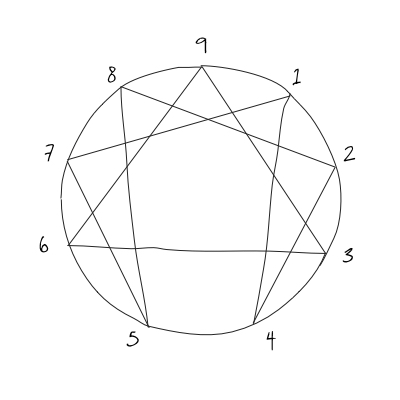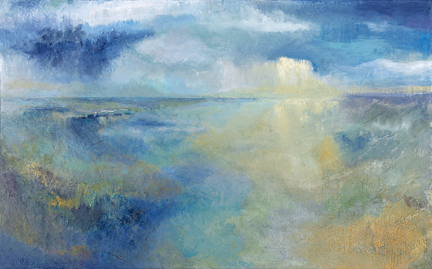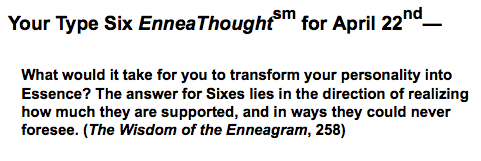
by Sandy | Aug 6, 2018 | Enneagram
The Enneagram is a model of nine distinct personality types. This may sound like something that could offer an simpler model than the MBTI (Myers Briggs Type Indicator). Nine types compared to sixteen of the MBTI – right?
My experience is that the Enneagram provides richness and depth and that, in fact, it demands a deeper commitment than the MBTI. So why bother?
Somewhere along the career path some folks run into territory where a mechanistic or tactical approach simply won’t provide any answers. What to do next becomes a spiritual journey. When that happens the Enneagram offers a window to an uncannily accurate look at who you are and how your worldview shapes your reality.
It requires some work to have this kind of conversation – even if it’s with yourself.
In case I have scared you off completely, the Enneagram can also be viewed on a simple practical level and can work well in conjunction with the MBTI. For example, my Enneagram type six is sometimes referred to as the Loyal Skeptic. My worldview is that the world isn’t always what it seems on the surface. The quest of the six is searching for certainty. The point of growth is in recognizing that certainty doesn’t exist. The other part of the path of growth for the six is to learn to trust that no matter what the circumstances they will be able to handle what comes their way.
In a real work situation my style is to “be prepared” beyond what might be required so that I can have the flexibility in the moment to throw it all away and respond to the needs of the people in the room.
I also have a strong influence from the Enneagram type seven that is aligned with the optimistic, cheerleader aspects of my MBTI ENFP preferences. The Enneagram helped me to understand the fear and doubt that often runs silently below the surface of my enthusiasm.
Curious about yourself? Want to see more of the model?
Here is a mini- quiz that has 38 0f the 144 questions on the Riso-Hudson Enneagram Type Indicator (RHETI). As with any quiz it is also important to confirm your type in addition to the results of the assessment tool.
I can help you to clarify your results and to apply what you understand about your type to your work/life situation. Send me a message.

by Sandy | Jun 4, 2018 | Enneagram, MBTI Facts
This is a tale of apples and oranges. The MBTI and Enneagram are two very different personality typologies which look at very different things. They work well when used in conjunction to provide a fuller understanding of what make us tick just as apples and oranges both contribute to making an excellent fruit salad.
The MBTI is based on the work of Karl Jung and it looks at the conscious functions of taking in information through the functions of Sensing and Intuition and making decisions through Thinking or Feeling. The underlying assumption is that one way of doing this is not inherently better than another. It is a preference one has that is in fact not an indication of skill or talent but of what is often most accessible and therefore most often practiced. The 4 letter code that makes up the 16 different MBTI types helps to indicate how these functions interconnect. Most MBTI literature focuses on the positive or more neutral aspects of the types before looking at what happens “in the grip” of stress.
The Enneagram has a history that is more esoteric. It dates back before the mystic schools of Islam where the Sufis used aspects of the Enneagram in the spiritual development of initiates. When the Enneagram was brought to the West the first teachers were exploring questions in psychology concerned with dysfunction. The Enneagram looks at the world of the unconscious and how the 9 different worldviews outlined by the Enneagram influence our orientation to the world. The current teachers of the Enneagram have shifted the focus from the shadow aspects of personality to focusing on real world applications of the model for business and self development.
Mapping One onto the Other
There isn’t a direct correlation- hence the apples and oranges analogy. There are some things that may be typical however given the understanding that there is an exception to every one of these forced correlations.
Enneagram 5 and I,T
Enneagram 8 and E
Enneagram 2 and F
Enneagram 7 and E,P
Enneagram 1 and J
Enneagram 3 and E
Enneagram 9 and I
Enneagram 4 and I,N,F
Some authors and researchers such as Tom Flautt and Renee Baron with Elizabeth Wagele have mapped this even more extensively than my very limited correlations. They too add the cautionary tale of exceptions being a distinct possibility.
Using these tools
The MBTI has a validated inventory that has one publisher so that it is readily recognized across sectors as a valuable tool in business for team building and personal development. People can recognize areas of possible strength and what else may need looking after. The downside is the perception that it can be learned and applied in a one time event. Without reinforcement the MBTI type may be forgotten and shelved MBTI-amnesia!
The Enneagram has a variety of assessments that have been tested to various degrees. It comes out of the oral tradition and is best learned by watching participants discuss their type in a workshop setting. Then you can see the physical characteristics, patterns of speech as well as hearing typical ways of focusing attention. Even though it may not have been as rigorously tested for validity the Enneagram has its own distinct advantages in certain circumstances. It too can be effective for personal development and creating understanding in teams. The Enneagram is uncannily accurate in capturing core dynamics. In part this means that the disowned shadow elements are also on the table from the beginning and some people find this challenging.
My personal take is that the Enneagram is a harder “sell” in a business environment, but a very important tool that anyone serious about leadership ought to consider. It isn’t the easiest route to take but the rewards of self knowledge at the deepest level make it worth the effort. At the end of the day real leaders need to dig deep to take people into uncharted territory.
Knowing both tools adds the distinctions that make for a truer picture. Mastery is in the ability to make these kinds of distinctions.
Please don’t make me choose I am delighted to have both in my toolkit.

by Sandy | May 26, 2018 | Enneagram, MBTI Facts
We are wired to try to make sense of the world, but when it comes to the MBTI or any other assessment tool – one lens simply does not explain everything.
When something isn’t working about the behaviour of someone else, it is tempting to develop theories to explain what is happening. If people know the MBTI they may use type or preference differences as their rationale. When the statements they make take the form of sweeping generalizations “I don’t like Extraverts they always yell instead of talking and I can’t hear myself think.” there is the possibility of creating much more harm than good.
So before we go painting everyone of a certain preference with the same paint brush let’s take a breath. Perhaps this person’s behaviour is objectionable because of their level of development. There might also be several other possible explanations that aren’t about personality type.
The Enneagram addresses this issue in a direct manner. The way the Enneagram is presented by Riso and Hudson adds levels of development to their look at type. At higher levels a person tends toward being open and expansive as opposed to restricting and reacting at the lower levels. It is very helpful to see behaviours that are healthy and how type may function in an unhealthy way. This saves labeling a certain negative behaviour as being a characteristic of the type as a whole. The individual in question may simply be less developed and have behaviour that reflects this.
HINT: Words like “always, never, everyone, everywhere” mark out something that needs to be examined a little closer to find the truth.
HINT #2: Consider this quote from Jung himself
Everything that irritates us about others can lead us to an understanding of ourselves.

by Sandy | May 17, 2018 | Enneagram
In self-development work it seems to me that people often fall in love with the first assessment tool that offered them some insight. The Enneagram is that tool for me. This model of nine worldviews and ways of focusing attention was the first window that allowed me to see that how I was in the world made sense in the larger scheme of things. At the same time it held up a mirror so that for the first time I understood the concept of “blindspot” and how mine played out in my thinking and behaviour.
During a visit to Victoria British Columbia I attended an Introduction to the Enneagram workshop hosted by Kira MacDuffee and Edward Colley. Both Kira and Edward use the Enneagram as a lens in their work with clients as Clinical Counsellors so they have an intimate familiarity with the model.
While their presentation was chock full of useful and practical applications of the the model what I appreciated most was just how grounded their teaching was in the deeper meanings offered by the Enneagram. One of the things that initially appealed to me about the Enneagram was illustrated by the respectful approach taken by my first teachers. Kira and Edward made a point of setting the training in a historical context and helping us make the distinction between finding our type as an orientation – a home base and using it as yet another way to excuse or restrict ourselves. They reinforced the importance of not using the model label but rather to understand possible dynamics between essence qualities and how our personality acts to compensate for loss of connection with that essence quality.
The participants in the workshop responded to this approach willingly engaging in exercises designed to mark out how aspects of the various types are alive for each of us. One woman, an Enneagram Four expressed the impact of taking an online Enneagram assessment, ” When I got my Enneagram results it was one of the few times I’d felt seen and by a computer at that!”
The reminder that the Enneagram is a map of how we have lost our connection to our central nature, a look at our strategy to avoid pain was enough to remind me why I fell in love with it in the first place. It has helped me develop compassion for myself and others.
Thank you Kira and Edward

by Sandy | May 15, 2018 | Enneagram
A reader asks “What do you think about a (F) 4 and a (M) 5 in relationship?”
It is not the best use of the Enneagram or any model of personality to use it as a predictor. However the Enneagram can be a resource to understand a particular dynamic that may be currently influencing the interaction between two people or that might potentially influence their relationship. Don Riso and Russ Hudson’s work lays out Levels of Development for each type. All types can be in relationship with any other type. The biggest influencer is the health of an individual. Health in this sense has to do with what level of development the person “hangs out in” the most – how aware they are about the impact they are making on others, how mindful they are in the present and how much they take responsibility for their actions. Anyone addicted to the hero, villain or victim role can prove toxic to any relationship.
Most of the time people don’t drive out the Enneagram in their everyday conversations about how they are getting along. When something does arise that interrupts the connection or natural flow between two people, the Enneagram shines a bright light on what is in play and can show a way to shift the energy of what is happening.
Both Four and Five are withdrawing types, so they can be caught up in their own interior world. For the Five that world is one of intellectual abstraction. The Five pulls back from the impingement of emotional entanglement to observe and gather information. The Four is all about understanding the territory of the heart and the subtleties of emotional tonality. The trick is to find the way into each others world. The Four will need to give space for the Five and modify their considerable demand for attention. Consider the alternative – the more the Four demands a “connection” the further the Five retreats to protect their need for the safety of emotional detachment.
The Five can benefit hugely from understanding the world of feelings and learning to recognize and stay with their own feelings. While Fours and Fives are on the opposite poles of emotional connection, they have the most to learn from each other. This pairing can go either way ending with both parties contracting further into their own interior realm or meeting in the middle and consequently balancing out their own tendencies.
For more information see Helen Palmer’s “The Enneagram in Love and Work”.
As a final comment – my aunt once gave me a life lesson for which I am grateful. She questioned me about the word “relationship”. She said that it was LOVE that mattered. That shifts the conversation and the kinds of things that matter, where you focus your attention and what you are willing to do to nurture the love.

by Sandy | Apr 22, 2018 | Enneagram
April 22nd’s Enneagram tip to realize ” how much I am supported” could not have come at a better time.

“Transforming to Essence” is an enormous quest. HAVING a personality seems like a necessary evil. However I truly love the idea of shifting things when elements of my personality HAVE me.
Each of us has our own challenge. As an Enneagram Six the “doubting mind” is the devil I know well. This Enneagram tip appeared in my email the evening after I returned from a bookclub meeting. As I was leaving the meeting, I happened to notice that the hostess had one of my paintings in each of the 4 directions… paintings North, South, East and West. I was bowled over, perhaps because of the concept of the 4 directions. Because I had always known that my friend had some of my work. I mentioned the coolness of the 4 directions to the group and others chimed in about paintings of mine that they enjoyed at their home, at the cottage or in Florida which covers at least 2 directions on another scale.
When I read this message from “The Wisdom of the Enneagram” it struck me that I am totally blessed and supported even when I am feeling otherwise. It also struck me that I have had this awareness before. The Enneagram teaches that what we focus our attention on creates our reality. So this tip is a good reminder.
It was cool that I had the experience of realizing that I was supported before I had the nudge. Progress?
I think progress is a better measure of success than expecting perfection or transformation.
Want to subscribe to EnneaThought for the Day…







